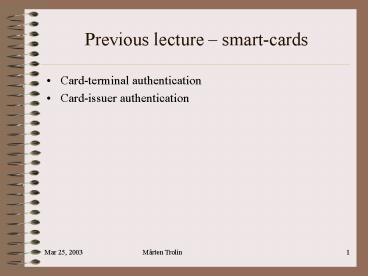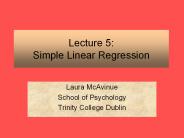Previous lecture - PowerPoint PPT Presentation
1 / 26
Title:
Previous lecture
Description:
Completely solved assignment gives 20 points. Six points ... Send the key to recipient by physically secure means, e.g., by courier, by registered mail etc. ... – PowerPoint PPT presentation
Number of Views:15
Avg rating:3.0/5.0
Title: Previous lecture
1
Previous lecture smart-cards
- Card-terminal authentication
- Card-issuer authentication
2
Todays program key generation and distribution
- About previous assignment
- New assignment
- Generating keys
- Distributing keys
- Key splitting
- Master key and derived keys
- Key lengths
- Symmetric keys
- Asymmetric keys
3
Assignment
- Completely solved assignment gives 20 points
- Six points deducted if chaining not implemented
- Penalty for delay one point per day
- Common problems
- Static Initialization Vector (IV)
- Padding not bijectional
- Encryption algorithm used
4
Initialization Vector (IV)
- In CBC mode, the IV is used for the first XOR
- Using a constant IV always gives the same
ciphertext for a certain clear text. - A good system should generate the IV dynamically
- From some random generator
- From the system time, etc.
- Since the IV is necessary for decryption, the IV
must be given in clear in the output - The IV itself is not secret, and giving it in
clear does not create a security problem.
5
Padding
- If the clear text is not a multiple of the block
length, some padding must be used. - The padding must be bijectional, i.e., the extra
characters added must be removed after decryption - Padding by adding spaces to the clear text does
not work, since you cant know if the spaces were
added during padding, or if they were in the
clear text from the beginning - How to create a bijectional padding?
6
Bijectional padding schemes
- A padding scheme is bijectional if depad(pad(s))
s. - If there are certain characters that for some
reason cannot appear in the clear text, they can
be used for padding. - In general, this is not a good solution, since
such conditions may change. - Example Let l be the length of the original
clear text, and let b be the block length. Set l
the smallest multiple of b such that l gt l.
Create a string of length l whose first l bytes
are the clear text. Set the last byte to l - l. - This is reversible, since when decrypting, it is
possible to read the last byte and remove the
corresponding number of padding characters.
7
Encryption algorithm used
- In the assignment, you need the basic DES
encryption. - Since ECB (Electronic Code Book) provides
encryption without any further processing, this
is what we want. - In Java, use DES/ECB/NoPadding
- In other libraries, either call DES directly, or
ECB without padding
8
New assignment
- Create signature according to EMV specifications
(15 p) - Create issuer certificate according to EMV
specifications (5 p)
9
Generating keys
- Key generation requires a good source of random
bits - Bad key material makes system vulnerable to
attacks. Has been done in practice. - Hardware generators provide the best source.
- For end-user applications - some user interaction
can be used (mouse movement, key strokes, etc.) - Using system time for high security requirements
is a bad idea! - For high-security applications, key generation
should take place in a closed environment.
10
Distributing symmetric keys
- Symmetric keys are very sensitive and must be
distributed with great care. - Depending on how valueable the key is, different
approaches are possible. - Send the key to recipient by physically secure
means, e.g., by courier, by registered mail etc. - If a common key exists, send the new key
encrypted under the common key. - Split the key into components and send the key
components with different security officers.
11
Key splitting
- One option for distributing keys with lower risk
is to split the key into components and send the
parts separately. - After generation, the key is split into n parts.
To recreate the key, all n parts must be
available. - Knowledge of less than n parts should give as
little help as possible for recreating of keys. - How do we do this?
12
Splitting into parts of equal length
- When splitting into parts of equal length, the
key of length l is split into n components, each
of length l / n. - First part consists of bits 1 through (l / n)
1, second part of bits l / n though 2(l / n) 1,
etc. - A disadvantage of this method is that knowledge
of several parts reveals parts of the key, and
leaves fewer bits for guessing.
13
Exclusive-or with random bit strings
- If we want to distribute an l-bit key k as n
components, we first generate (n 1) l-bit
strings u1, u2, , un 1. - The nth component is computed as un k ? u1 ?
u2 ? ? un 1, where ? denotes bitwise XOR. - The basic properties of XOR gives that u1 ? u2 ?
? un k. - This method gives higher security, since
knowledge of either n 1 components reveals
nothing about the key. - Recall that with the previous method, this
knowledge revealed several key bits, making a
brute-force attack on the rest easier.
14
Distributing keys for asymmetric keys
- Distributing the public part of asymmetric keys
is simple no special security measures are
needed. - Distributing keys in certificates makes it easier
to prove the owner of the key. - If the private part is to be distributed, the
same techniques as for symmetric keys can be used.
15
Key Derivation
- Key derivation is a technique to assign
individual keys without having to store a key per
user. - The key information is concentrated into a single
master key. - Every key is derived from this master key.
- The individual keys are computed on-the-fly from
the master key and user information.
User information
Encryption
Master key
Individual key
16
Session Keys
- For security reasons it is often a good idea to
use different keys for each transaction. - Keys used only for one transaction are called
session keys.
Session information
Encryption
Individual key
Session key
17
Key Management Setup
System A
System B
- If two systems need to share a common symmetric
key, there are several possiblities. - Can be created by system A and transferred to
system B. - Can be created by system A and transferred to
system B. - Can be created by a third party and transferred
both to system A and system B.
Master Key
Master Key
Master Key
Master Key
Key generation
18
Zone Master Key ZMK
- If the two systems have one common symmetric key,
this key can be used to encrypt other keys that
are sent between the systems. - This key is often called Zone Master Key, ZMK.
- Once this common key has been established,
exchanging further keys is simple.
19
Symmetric Key Management Zone Master Key
Host system
Configuration system
ZMK Component 1
ZMK Component 2
ZMK Component 3
Components reassembled as the host to give the
same key
Generation of Zone Master Key
Zone Master Key sent as components to host by
security officers
20
Transfer of Zone Master Key
- When transferring the Zone Master Key, no single
person will see the key. - Key components are given out only one at the
time, so that no one person sees all components. - When combining the components, each component is
first encrypted. Only when all components are
encrypted do the security officers meet and give
all components.
21
Symmetric Key Management Key Export
System A
System B
Key
ZMK
ZMK
Key
System A and system B shares ZMK
Symmetric key encrypted under ZMK and sent
Symmetric key generated
Symmetric key decrypted at system B
22
Key length
- Apart from selecting a good algorithm, the key
length to be used must be chosen. - When selecting the key length, you need to take
into account security requirements and hardware
costs. - Longer keys are more secure, but encryption and
decryption takes longer time. - How sensitive is the data? Do we need to protect
it for twenty seconds, twenty days or twenty
years? - Who do we want to protect ourselves against? The
causal eaves-dropper, a competing company or a
foreign government?
23
Symmetric key lengths
- If the symmetric cipher is good, the only way to
break the key is to do exhaustive search. For an
n-bit key, this requires 2n iterations. - As of today, 64-bit keys take a few years to
crack for someone with enough resources. 128-bit
keys are virtually impossible to break, and are
likely to stay that way for the foreseeable
future. - Since encryption and decryption is fast, there is
usually no reason to use less than 128 bits.
24
Symmetric key lengths
- The graph below demonstrates how the time
necessary to break a key depends on the key
length.
25
Asymmetric key lengths
- For asymmetric systems, there are much more
efficient ways than exhaustive search to retrieve
the key. - For RSA, factoring the modulus gives the private
key. - The longest RSA key that is publicly known to
have been broken is 512 bits. - Two years ago, this required 30 CPU-years.
- 1024 bit keys probably remain secure for the next
years. - Be very careful with comparisons between strength
of symmetric and asymmetric keys!
26
Asymmetric keys
- Asymmetric keys often have a longer life-span
than symmetric keys. - Symmetric keys are used for session encryption,
which often has to be kept secret only for a
limited period. - Asymmetric keys are used for signatures that may
have to remain secure for several decades. - Analyze the situation and choose the most
appropriate solution!































